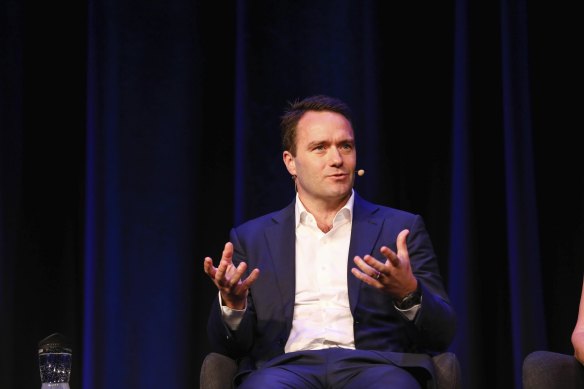This was published 2 years ago
Developer pushes to mandate social, affordable housing at all new projects
By Megan Gorrey and Michael Koziol
Infrastructure giant Lendlease says the government should require all new developments to contain at least 30 per cent affordable, social and build-to-rent homes to help ease Sydney’s chronic housing affordability crisis and bring the city into line with world leaders.
In a pre-election intervention into the red-hot housing debate, Lendlease’s managing director of development said all new housing projects – not just those on public land – should be mandated to include a mix of housing types.

Tom Mackellar, managing director of development at Lendlease.Credit: Dominic Lorrimer
“We believe that – we’ll call it 30 per cent – should be allocated to diverse uses of housing, so social, affordable and build-to-rent housing, and really create a requirement for a mix of housing on all the new developments,” Tom McKellar told the Committee for Sydney’s Sydney Summit on Monday.
“The first [thing] is setting measurable targets around the delivery of social and affordable housing in any new development project ... we have said 30 per cent would be a great number to start with.”
While big developers are more likely to sign off on a housing diversity mandate, smaller ones would be reluctant, and it is likely that such a rule would be adjustable and apply mostly to large projects.
Under similar schemes contemplated in other jurisdictions and by some Sydney councils, developers would receive a floor space ratio bonus – effectively, be allowed to build higher – based on how much affordable housing they include in the project.
Overseas, governments routinely set quotas for housing diversity, including affordable homes, on major projects. Mackellar said Lendlease’s residential projects in the United Kingdom typically included between 30 and 50 per cent affordable housing.
Lendlease is developing a $4 billion urban renewal project in the Elephant and Castle area of London which will deliver 3000 new homes, a quarter of which are earmarked as affordable. It also claims to be the UK’s first climate-positive development when complete in 2025.
“In precincts we’re doing across our portfolio internationally, we often use a rule of thirds – a third is social [or] affordable, a third is build-to-rent and a third is market housing,” Mackellar said.
Asked about quotas for housing types, Australian developer giant Mirvac said it supported mandating a portion of social and affordable housing on future developments on government-owned sites, but would not comment on privately developed sites.
If elected in March, Labor has committed to a requirement for 30 per cent of homes built on surplus government land to be set aside for social, affordable and “universal” housing. Planning spokesman Paul Scully said on Monday that “where there are opportunities and it’s sensible to go higher, we obviously would”.
Scully also said there should be a conversation with the private sector about requiring more diverse housing types on private land “because no one’s cracked that nut ... if we can get to a similar sort of thing to what [Lendlease] is talking about, I’d welcome it”.
Planning Minister Anthony Roberts said the Coalition government had invested $2.8 billion in the 2022 housing package, and had committed to 30 per cent affordable and diverse housing on sites owned by the Transport Asset Holding Entity of NSW.
He said the government was making better use of public land by offering long-term ground leases and had instructed Landcom to expand its footprint in regional NSW and raise the affordable housing target to at least 20 per cent by 2025.
Mackellar said development projects which contained a mix of housing and tenancy types were attractive for developers because they provided a wider customer base and the developments were absorbed into the market more quickly.
But he warned that integrating more social and affordable homes into new developments would require greater community acceptance of mixed housing projects in new and established suburbs.
“The burden of mixed housing can’t be pushed away,” he said. “This should be something that we see right across Sydney, and not just put in new parts of Sydney.”
Mackellar also suggested mandatory targets for rental accommodation in all new developments. More than 37 per cent of Sydneysiders rent, and rents have recently spiked to record highs.
“Build-to-rent and that whole sector ... is one of the interventions ... that you are again mandating on new projects all through the planning system,” Mackellar said.
Our Breaking News Alert will notify you of significant breaking news when it happens. Get it here.